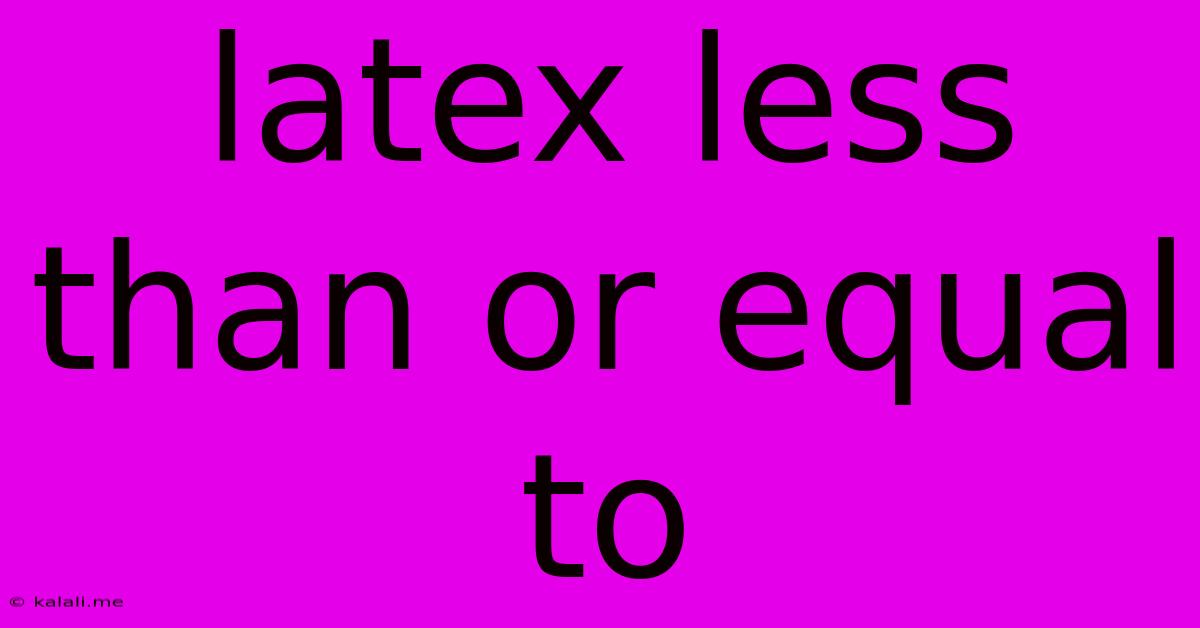Latex Less Than Or Equal To
Kalali
Jun 04, 2025 · 2 min read

Table of Contents
LaTeX Less Than or Equal To: A Comprehensive Guide
This article provides a comprehensive guide to using the "less than or equal to" symbol in LaTeX, covering various styles and contexts. Understanding how to correctly implement this symbol is crucial for writing clear and professional mathematical documents. We'll explore different methods, ensuring your LaTeX documents are both aesthetically pleasing and mathematically accurate.
Understanding the Symbol and its Usage
The "less than or equal to" symbol (≤) is a fundamental mathematical symbol used to denote inequality. It indicates that one value is less than or equal to another. Correctly representing this symbol in your LaTeX documents is vital for conveying mathematical concepts accurately. Incorrect implementation can lead to misinterpretations and detract from the overall professionalism of your work.
Methods for Implementing "Less Than or Equal To" in LaTeX
The simplest and most common way to represent "less than or equal to" in LaTeX is using the \le command. This command produces the standard mathematical symbol: ≤.
$x \le y$
This will render as: x ≤ y
This method is generally preferred for its simplicity and readability within your LaTeX code.
Variations and Considerations
While \le is the standard and recommended approach, there are other options to consider depending on your specific needs and stylistic preferences. These are less common but might be useful in certain contexts:
-
Using the
leqcommand: In some packages or contexts, you might encounterleqcommand. It produces the same result as\le. However,\leis generally more portable and widely recognized. -
Font Considerations: The appearance of the ≤ symbol might vary slightly depending on the font used in your LaTeX document. This variation is usually minimal and shouldn't significantly impact readability.
Contextual Usage and Best Practices
The \le command works seamlessly within various LaTeX environments, including:
-
Inline mode: As shown in the examples above,
\leworks perfectly within inline mathematical expressions. -
Display mode: The symbol renders equally well within displayed equations (using
\[...\]or\begin{equation}...\end{equation}). -
Other mathematical environments: The command functions consistently within environments like
align,gather, and other equation-specific environments.
Troubleshooting and Common Errors
One common error is forgetting to enclose the mathematical expression within dollar signs ($...$ for inline mode or \[...\] for display mode). Without these delimiters, LaTeX will not interpret \le as a mathematical command.
Conclusion
Using the \le command in LaTeX is the straightforward and recommended approach for representing "less than or equal to." By understanding its usage within different contexts and adhering to best practices, you can ensure that your mathematical expressions are accurately rendered, enhancing the clarity and professionalism of your LaTeX documents. Remember to always ensure your mathematical expressions are properly delimited using dollar signs or equation environments. This simple step will prevent many common errors.
Latest Posts
Latest Posts
-
How To Write Spoiler Alert In A Sentence
Jun 06, 2025
-
How To Stop Opening Up With Launcpad Website
Jun 06, 2025
-
How To Change From Text Message To Imessage
Jun 06, 2025
-
How To Insulate Tuff Shed Floor
Jun 06, 2025
-
Me And No Not At All
Jun 06, 2025
Related Post
Thank you for visiting our website which covers about Latex Less Than Or Equal To . We hope the information provided has been useful to you. Feel free to contact us if you have any questions or need further assistance. See you next time and don't miss to bookmark.